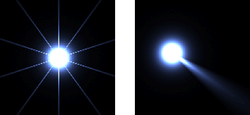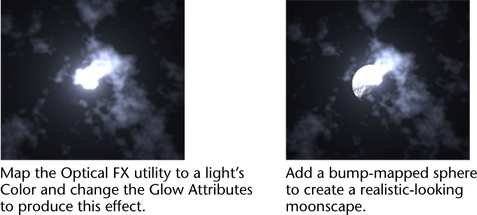The Optical FX Attributes control the appearance of glows, halos, and lens flares.
For more information about optical effects, see Glows, halos, and lens flares.
Simulates a bright light source illuminating the surfaces of a camera’s lens. The flare intensity is determined by the Flare Intensity value. The size of the flare circles is relative to the field of view of the camera. Lens Flare is off by default. Check Lens Flare on to access Lens Flare Attributes.

The type of glow the light produces when viewed directly. Click the arrow to access available glow types from the drop-down list.
A light does not need glow to illuminate objects when the scene is rendered, however a light does need glow to be visible by the camera when the scene is rendered. The default Glow Type is Linear.
The following examples show a yellow glow (Glow Color) and all other Glow attributes left at the default settings.
The type of halo the light produces when viewed directly. Halo is similar to Glow, except that the fall off is more gradual and different fall-off types are available. The default setting is None. Click the arrow to access the drop-down list.
The following show the different Halo types with the default Linear Glow Type, a red Halo Color, and the Halo Spread set to 0.75.
Controls the smoothness of glow radial noise (see Glow Radial Noise). The slider range is 0 to 5, but you can enter values up to infinity. The default value is 0.5.
Represents the number of points on glow star filter effects (see Glow Star Level). The following examples show a Star Points value of 20 and a Star Points value of 1 which produces a comet-like effect. Use the Rotation attribute to adjust the comet’s tail.

The slider range is 0 to 10 but you can enter values up to infinity. The default value is 4.
Rotates glow noise and star effects (Glow Noise, Glow Radial Noise, and Glow Star Level) about the center of the light. The slider range is 0 to 360 (degrees) but you can enter values up to infinity. The default value is 0.
Also accessible through the material’s Special Effects attributes (see Special Effects). Controls the glow brightness. As the Glow Intensity value increases, so does the apparent size of the glow effect. A negative Glow Intensity value subtracts from other glows. (The light’s Decay Rate controls how the glow brightness decreases with distance.) The slider range is 0 to 10, but you can enter values up to infinity. The default value is 1.
Controls the strength of two-dimensional noise applied to the glow. The noise is generated on a plane centered at the location of the light and always oriented towards the camera. The slider range is 0 to 1. The default value is 0.
To create the illusion of illuminated smoke around a glowing light source, set the Glow Noise value to about 0.5 and slowly animate the Noise Uoffset and Noise Voffset values. The smoke appears to slowly drift by the light.
The following example shows how you can create a moody night sky simply by adjusting a few Glow Attributes. The Optical FX attributes used in this example are as follows:

Randomizes the spread of the glow to simulate starburst effects and eyelashes refracting light. The slider range is 0 to 1. The default value is 0.
Negative values of Glow Radial Noise produce thicker noise. Use the Radial Frequency attribute to control the smoothness of this effect.
Simulates camera star filter effects. The slider range is 0 to 4. The default value is 0. Use the Star Points attribute to set the number of points on the star. Use the Rotation attribute to rotate the star.
These attributes are only accessible if Lens Flare is turned on in Optical FX Attributes.
Represents the number of circles in the lens flare effect. The valid range is 0 to infinity. The slider range is 0 to 30. The default value is 20.
If the Flare Num Circles value is very large, rendering times may be long, especially if the Flare Min Size and Flare Max Size values are large and the Flare Color is textured.
Controls the flare effect length relative to the light location. If Flare Length is small, all circles overlap the light. If Flare Length is large, the circles spread out across the image. The Flare Length value has no effect if the Flare Vertical and Flare Horizontal values are both 0. The slider range is 0 to 1. The default value is 1.
See also Glow Noise.
Offsets glow noise in the horizontal (Noise Uoffset) and vertical (Noise Voffset) directions.
For example, you can animate the Noise Uoffset and Noise Voffset values to simulate smoke, rain, or snow moving past a light. Noise repeats after an offset of 1. The slider range is 0 to 1. The default value is 1 for Noise Uoffset and 0.5 for Noise Voffset.
 Except where otherwise noted, this work is licensed under a Creative Commons Attribution-NonCommercial-ShareAlike 3.0 Unported License
Except where otherwise noted, this work is licensed under a Creative Commons Attribution-NonCommercial-ShareAlike 3.0 Unported License